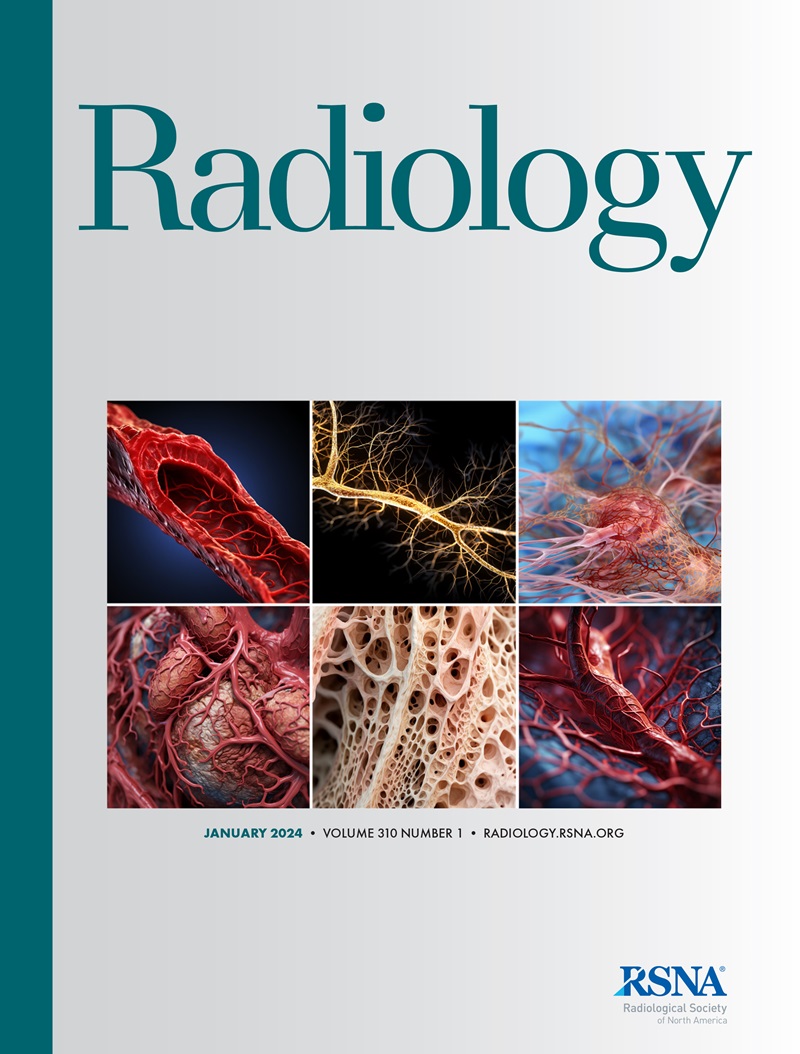Tong-Yi Huang, Zhi-Yan Li, Jie Tian, Xiao-Juan Xie, Jeong Min Lee, Xin-Ping Ren, Xiao-Yan Xie
求助PDF
{"title":"定量美国代谢功能障碍相关脂肪变性肝病:国际前瞻性研究","authors":"Tong-Yi Huang, Zhi-Yan Li, Jie Tian, Xiao-Juan Xie, Jeong Min Lee, Xin-Ping Ren, Xiao-Yan Xie","doi":"10.1148/radiol.242564","DOIUrl":null,"url":null,"abstract":"<p><p>Background Quantitative US is promising in assessing metabolic dysfunction-associated steatotic liver disease (MASLD), but prospective multicenter studies are lacking. Purpose To evaluate the diagnostic performance of quantitative US in assessing MASLD and metabolic dysfunction-associated steatohepatitis (MASH). Materials and Methods This prospective study included participants with MASLD from tertiary hospitals in China and Korea, undergoing multiparametric US from August 2021 to December 2023. Diagnostic performance of tissue attenuation imaging (TAI), tissue scatter-distribution imaging (TSI), and two-dimensional shear-wave elastography (SWE) parameters for assessment of MASLD and MASH was evaluated using area under the receiver operating characteristic curve (AUC) analysis, with histopathologic analysis as a reference. Univariable and multivariable analyses identified clinical factors associated with each US parameter. Results A total of 114 participants (median age, 40 years; IQR, 31-50 years; 67 female participants) were evaluated, 76 participants (67%) with MASH and 39 participants (34%) with high-risk MASH (fibrosis score ≥F2). Multivariable analysis indicated TAI and TSI were independently associated with steatosis and SWE was independently associated with fibrosis (all <i>P</i> < .001). TAI and TSI showed excellent performance for assessing steatosis grades S1 or higher, S2 or higher, and S3 (AUCs for TAI: 0.90, 0.93, and 0.78, respectively; AUCs for TSI, 0.94, 0.89, and 0.80, respectively), with TSI demonstrating good performance for inflammation grade I1 or more (AUC, 0.84; 95% CI: 0.75, 0.92; sensitivity, 79%; specificity, 79%). SWE exhibited excellent performance for staging fibrosis scores of F1 or higher, F2 or higher, F3 or higher, and F4 (AUCs: 0.81, 0.96, 0.89, and 0.97, respectively; sensitivities: 75%, 90%, 87%, and 100%, respectively; specificities: 80%, 93%, 83%, and 96%, respectively). The combined TSI and SWE model showed diagnostic advantages for MASH (AUC, 0.92; 95% CI: 0.85, 0.98) and high-risk MASH (AUC, 0.82; 95% CI: 0.74, 0.90) compared with TSI (<i>P</i> = .72 for MASH; <i>P</i> = .002 for high-risk MASH) and SWE (<i>P</i> < .001 for MASH; <i>P</i> = .31 for high-risk MASH). Conclusion TAI, TSI, and SWE helped provide accurate assessment of MASLD, and combining TSI and SWE showed good discrimination for predicting MASH and high-risk MASH. ClinicalTrials.gov Identifier: NCT04985188 © RSNA, 2025 <i>Supplemental material is available for this article.</i> See also the editorial by Dighe and Dhyani in this issue.</p>","PeriodicalId":20896,"journal":{"name":"Radiology","volume":"316 1","pages":"e242564"},"PeriodicalIF":12.1000,"publicationDate":"2025-07-01","publicationTypes":"Journal Article","fieldsOfStudy":null,"isOpenAccess":false,"openAccessPdf":"","citationCount":"0","resultStr":"{\"title\":\"Metabolic Dysfunction-Associated Steatotic Liver Disease at Quantitative US: International Prospective Study.\",\"authors\":\"Tong-Yi Huang, Zhi-Yan Li, Jie Tian, Xiao-Juan Xie, Jeong Min Lee, Xin-Ping Ren, Xiao-Yan Xie\",\"doi\":\"10.1148/radiol.242564\",\"DOIUrl\":null,\"url\":null,\"abstract\":\"<p><p>Background Quantitative US is promising in assessing metabolic dysfunction-associated steatotic liver disease (MASLD), but prospective multicenter studies are lacking. Purpose To evaluate the diagnostic performance of quantitative US in assessing MASLD and metabolic dysfunction-associated steatohepatitis (MASH). Materials and Methods This prospective study included participants with MASLD from tertiary hospitals in China and Korea, undergoing multiparametric US from August 2021 to December 2023. Diagnostic performance of tissue attenuation imaging (TAI), tissue scatter-distribution imaging (TSI), and two-dimensional shear-wave elastography (SWE) parameters for assessment of MASLD and MASH was evaluated using area under the receiver operating characteristic curve (AUC) analysis, with histopathologic analysis as a reference. Univariable and multivariable analyses identified clinical factors associated with each US parameter. Results A total of 114 participants (median age, 40 years; IQR, 31-50 years; 67 female participants) were evaluated, 76 participants (67%) with MASH and 39 participants (34%) with high-risk MASH (fibrosis score ≥F2). Multivariable analysis indicated TAI and TSI were independently associated with steatosis and SWE was independently associated with fibrosis (all <i>P</i> < .001). TAI and TSI showed excellent performance for assessing steatosis grades S1 or higher, S2 or higher, and S3 (AUCs for TAI: 0.90, 0.93, and 0.78, respectively; AUCs for TSI, 0.94, 0.89, and 0.80, respectively), with TSI demonstrating good performance for inflammation grade I1 or more (AUC, 0.84; 95% CI: 0.75, 0.92; sensitivity, 79%; specificity, 79%). SWE exhibited excellent performance for staging fibrosis scores of F1 or higher, F2 or higher, F3 or higher, and F4 (AUCs: 0.81, 0.96, 0.89, and 0.97, respectively; sensitivities: 75%, 90%, 87%, and 100%, respectively; specificities: 80%, 93%, 83%, and 96%, respectively). The combined TSI and SWE model showed diagnostic advantages for MASH (AUC, 0.92; 95% CI: 0.85, 0.98) and high-risk MASH (AUC, 0.82; 95% CI: 0.74, 0.90) compared with TSI (<i>P</i> = .72 for MASH; <i>P</i> = .002 for high-risk MASH) and SWE (<i>P</i> < .001 for MASH; <i>P</i> = .31 for high-risk MASH). Conclusion TAI, TSI, and SWE helped provide accurate assessment of MASLD, and combining TSI and SWE showed good discrimination for predicting MASH and high-risk MASH. ClinicalTrials.gov Identifier: NCT04985188 © RSNA, 2025 <i>Supplemental material is available for this article.</i> See also the editorial by Dighe and Dhyani in this issue.</p>\",\"PeriodicalId\":20896,\"journal\":{\"name\":\"Radiology\",\"volume\":\"316 1\",\"pages\":\"e242564\"},\"PeriodicalIF\":12.1000,\"publicationDate\":\"2025-07-01\",\"publicationTypes\":\"Journal Article\",\"fieldsOfStudy\":null,\"isOpenAccess\":false,\"openAccessPdf\":\"\",\"citationCount\":\"0\",\"resultStr\":null,\"platform\":\"Semanticscholar\",\"paperid\":null,\"PeriodicalName\":\"Radiology\",\"FirstCategoryId\":\"3\",\"ListUrlMain\":\"https://doi.org/10.1148/radiol.242564\",\"RegionNum\":1,\"RegionCategory\":\"医学\",\"ArticlePicture\":[],\"TitleCN\":null,\"AbstractTextCN\":null,\"PMCID\":null,\"EPubDate\":\"\",\"PubModel\":\"\",\"JCR\":\"Q1\",\"JCRName\":\"RADIOLOGY, NUCLEAR MEDICINE & MEDICAL IMAGING\",\"Score\":null,\"Total\":0}","platform":"Semanticscholar","paperid":null,"PeriodicalName":"Radiology","FirstCategoryId":"3","ListUrlMain":"https://doi.org/10.1148/radiol.242564","RegionNum":1,"RegionCategory":"医学","ArticlePicture":[],"TitleCN":null,"AbstractTextCN":null,"PMCID":null,"EPubDate":"","PubModel":"","JCR":"Q1","JCRName":"RADIOLOGY, NUCLEAR MEDICINE & MEDICAL IMAGING","Score":null,"Total":0}
引用次数: 0
引用
批量引用

 求助内容:
求助内容: 应助结果提醒方式:
应助结果提醒方式:


